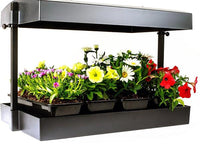Probiotic foods and supplements have been helping humans improve their gut health, immunity from disease, allergy control, nutrient absorption, and even brain health and mental health. In fact, beneficial bacteria and other microbes are REQUIRED for the human body to function properly. Recently, scientists have been studying the roles beneficial bacterial and fungal creatures play in the plants in your garden and grow room.
Let’s explore how probiotics help your plants thrive plus how to make your own probiotic potion for higher yields.
Probiotic Endophytes Reduce the Need for Plant Fertilizer
Sharon Doty, a University of Washington researcher, has been on the cutting edge of plant science for years now. She was once considered an agricultural heretic, but her discoveries are becoming more mainstream. That is great news for sustainable agriculture and grow operations across the globe.
Doty and fellow researchers were some of the first scientists to discover the existence of plant probiotics and how they work. In the plant world, these helpful creatures are called endophytes.
Not long ago, they isolated endophytes from willow and poplar trees that were thriving under bad soil conditions. They also managed to transfer them to other plants like rice.
These probiotic bacteria allowed the rice plants to grow taller, become more massive, and develop better root systems. Theoretically, the potential of these plants was limited because of low nitrogen.
What did these endophytes do to give such a big biomass boost? One thing they did was improve the efficiency of nitrogen uptake. The plants needed less nitrogen because the probiotic bacteria turned it into a form that the plants could more easily use.
This nitrogen “fixing” doesn’t just work on trees and rice.
Doty says:
“This research offers the potential alternative for chemical fertilizers in crop production, thus aiding sustainable agriculture with minimum impacts on the environment…
Research on endophytic nitrogen-fixation has enormous potential benefits since endophytes have a very broad host range. Unlike root nodules that are limited to [just a few plants], endophytic nitrogen-fixation could be used for any plant species.”
Probiotic Endophytes Adapt to Changing Conditions on Behalf of Your Plants
According to research by Doty and others, endophytes make up for the fact that most crops cannot easily adapt to nutrient depletion, heat, lack of moisture, crop-killing pathogens, or harmful toxins. That’s where probiotic endophytes come in.
These bacteria and fungi do the evolution so the crops don’t have to. Their rapid evolution not only allows the plants to survive, but to thrive as well.
Probiotics Produce Plant Hormones, Too
Traditionally, research on endophytes has focused on probiotics in soil and how they affect roots. Doty changed all that. She suffered from her heresy – like many innovators before her – and had many problems securing funding for her studies.
What she found is that different strains of bacteria have different functions, just like the probiotics in the human body. Some species will enter the whole plant, not just the roots. They may influence water transport, sugar transport, and nutrient transport.
Some species will influence the plant’s endocrine systems and even produce beneficial hormones.
The end result? Happier and healthier plants.
How to Make a DIY Probiotic Spray for Your Plants
First of all, one thing you can do is “mulch” your soil grows with “black gold.” This is compost. Add a layer of it over the soil.
You can also make a spray with a simple list of ingredients.
People at the Creek House Organic Community Garden in Kansas City found a great way to increase beneficial bacteria and fungi using a molasses spray. A soil scientist told them at a conference that this method may be better than buying commercial plant microbe products.
The gardeners tested the soil expert’s advice, and it worked! Plants grew larger. Leafy vegetable plants grew bigger leaves.
The secret is to take microbes from your existing soil and feed them. This will multiply them. Then you can spray your grow operation with them.
Plant Probiotic Cocktail Spray Recipe
You will need:
- 1 Post hole digger
- Sulfur-free molasses (Plantation Blackstrap brand was the winner in the Kansas City tests)
- Filtered or distilled water
- “Dirt from undisturbed pasture, bottom land, prairie”
- A clean 1-gallon (4-liter) container
- pH testing papers or a pH meter
Step 1: Wait for the soil temperature to reach 60+ degrees Fahrenheit.
Step 2: Using a post hole digger, dig a hole three feet deep.
Step 3: For maximum biodiversity, collect a soil sample from your hole every six inches until you reach the bottom. Mix your samples together well.
Step 4: Wash your 1-gallon container with soap and water to prevent contamination.
Step 5: Add two cups (1/2 liter) hot (but not boiling) water to your container.
Step 6: Add 2.5 ounces of molasses to the container. Note: The guy who did the experiments worded this part strangely: “Add 2-1/2 oz molasses - = 2-1/2 shot glasses – this yields an approximate 2% solution.” He almost seems to be saying one ounce. However, 2.5 ounces of molasses in 128 ounces (one gallon) of water gives you a 2% molasses solution.
Step 7: Fill the container with filtered or distilled water until it’s half full.
Step 8: Add one cup from your well-mixed soil samples to the solution.
Step 9: Cap your container and shake it for a while.
Step 10: Fill the container with filtered or distilled water until the water reaches two inches below the neck.
Step 11: Store your solution until the foaming stops or until pH is 3.5 – 4.0. At 90 degrees F, this could take two weeks. You can use pH testing papers for measuring pH.
How to Use Your Probiotic Plant Spray
Mix one part of this mixture with 20 parts water. The Kansas City gardener says to use it as a foliar spray “on new and established seed beds.” You can also spray it on leaves, stems, and soil.
Does This Work for Hydroponics?
Feel free to experiment with that and let us know how it goes. Our contact info is below, and you can also leave a comment under this article.
Talk to a Growing Expert for Free
If you have questions about your grow or about grow products, call or text us or email us.
Grow Supply Shop
support@growsupplyshop.com
1-800-587-6207 | 9AM - 1PM PST TIME
#GetYourGrowOn
References
1 Kandel SL, Herschberger N, Kim S, Doty SL. Diazotrophic Endophytes of Poplar and Willow for Growth Promotion of Rice Plants in Nitrogen-Limited Conditions Crop Science. 2015; 55(4):1765-1772. https://acsess.onlinelibrary.wiley.com/doi/abs/10.2135/cropsci2014.08.0570
2 Santoyo G, Moreno-Hagelsieb G, del Carmen Orozco-Mosqueda M, Glick BR. Plant growth-promoting bacterial endophytes Microbiological Research. 2016; 183:92-99. https://www.sciencedirect.com/science/article/pii/S094450131530029X
3 Grotz t. Probiotics For the Soil: Brew Your Own Local, Indigenous Microbes. (Reader contribution). Mother Earth News. (February 11th, 2014). https://www.motherearthnews.com/organic-gardening/probioticsfor-the-soilbrew-your-own-local-indigenous-microbes-zbcz1402









